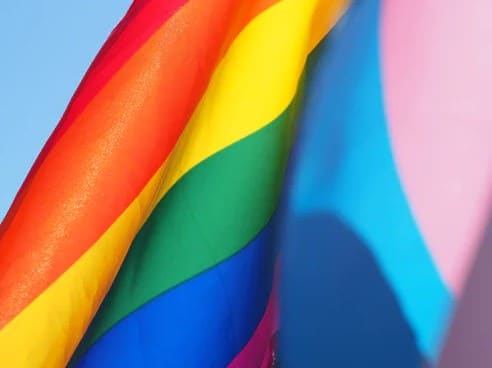 Outstanding or Overbearing?
Outstanding or Overbearing?Outstanding or Overbearing?
Engaging with the LGBTQ+ Community during Pride Month
It was the peak of Pride, the day of the Providence parade—a day I should have gotten to live my best and most authentic life. I parked at the mall to avoid paid parking and cut through the building to get to the celebration. I was looking forward to a day of parades, drag performers, pageants, and free goodies, not to mention seeing talented queer folks to perform while their audience exudes acceptance, love, and encouragement. I decided to stop at a store to grab a reusable water bottle – Pride can get extra warm. After looking for only about a minute, a store manager walked up to my friend and I and told us to leave. After a puzzled look, I said, “excuse me?” Maybe I had misheard. They then informed us, after glancing down at our rainbow outfits, that we didn’t belong in the store and that we should take our leave. Rushing through the mall trying to get outside, somebody spit at me and called me a derogatory slur.
Sounds like a nightmare from the last century, huh? If only.
– – –
This happened in 2019—the last time Pride celebrations took place in person. I am telling this story to remind us how important it is to talk about Pride and the LGBTQ+ community. Stigma builds in silence – so we need to be vocal about our support.
June, the month of Pride, has become a huge commercial campaign for many brands, but do they embody the purpose of the celebration? Are their efforts outstanding or overbearing? Pride started as a protest, and advancing queer civil rights – especially for communities of color – remains at its core. While some brands show their support well, others paint the town rainbow for all of the wrong reasons. When brands aren’t delivering well on their Pride messaging, it’s often a case of overdelivering or underdelivering.
Too Much
Brands love to do the most for Pride, but just decking a brand out in rainbows can create more noise than signal. Changing the color of logos doesn’t add any value or action to a brand’s statements; if the brand isn’t supporting the LGBTQ+ community year-round, they know that it’s a publicity stunt Corporate celebration can also drown out LGBTQ+ voices and the voices of allies. While a rainbow is a fun, colorful, and bright representation, it loses meaning when it’s splashed over everything without any meaningful accompanying messages. The color becomes just that – a color.
As a queer person, I can see through a rainbow logo. Such statements of support are fine but must be backed up with action. You don’t have to send your board members to a protest march (even though that is greatly appreciated); businesses can donate or fundraise for charities supporting LGBTQ+ people in need. Countless LGBTQ+ folks are experiencing homelessness, poverty, illnesses, unemployment, and other hardships. Don’t stop in July, either; when a brand starts talking about LGBTQ+ rights, continued action and advocacy is expected throughout the entire year.
Another common misstep is to tokenize LGBTQ+ staff by forcing them into the spotlight during Pride month. Coming out is something that people do to express themselves authentically. There should be no inherent expectation to speak on behalf of the entire community.
Not Enough
While inadvertently take away from the meaning of Pride while going over the top, others ignore it entirely. When brands ranging from banks to fast food chains make a point of celebrating pride, silence can seem intentional. The queer community and it allies are a powerful and growing market – you don’t want to alienate them. Finding the right balance between celebration and appropriation can be daunting, but that shouldn’t scare you away from acknowledging Pride. Any brand can tap into the joy and energy of the celebration and create meaningful communications—as long as you start with genuine community engagement
Engaging with the Queer Community
Make sure those crafting your organization’s messaging for Pride are well versed in queer culture. If your communications team isn’t already immersed in the community, there are hundreds of LGBTQ+ films, television shows, books, and other readings to use as research.
Prioritize actual LGBTQ+ voices when drafting your communications. The last thing LGBTQ+ people want to hear during Pride is someone straight-splaining their culture. Let the lived experiences, identity, and culture of queer folks (who are interested in and paid for doing this work rather than co-opted from their normal roles during Pride) be your guide. Use ideas and resources posted online by queer folks, properly attributing and compensating the sources. By gaining insight from multiple sources, you can empathize with the broader community.
Corporate Allyship
If your brand’s leadership doesn’t have any representation from the LGBTQ+ community, you can still be an ally! Allies are people who don’t identify as part of the LGBTQ+ community but work alongside them to support queer rights and social justice. Brands can be allies to the queer community by using their voice to do more than just sell a product. Amplifying the voices of the LGBTQ+ people who are being drowned out and silenced is a great way to show your audience that you genuinely care and want to be a part of the solution. Corporate allies need to be open, honest, informed, and passionate. Becoming an ally publicly can also inspire others brands take more action or to ask you questions if they do not understand. Homophobia, transphobia, and other acts of discrimination against queer people is still a prevalent societal issue. Let’s come together and make a more colorful, bright, and open-minded world together.
